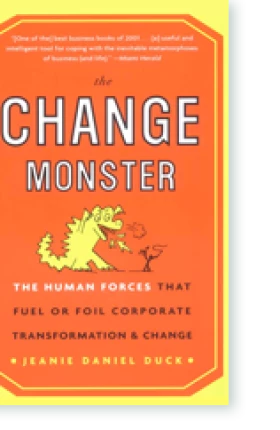Jeanie Duck is known for mixing Southern charm and sass with business insight and acumen. For the past three decades, she has used that mixture to good advantage in helping companies initiate change and make it stick. Her 2001 book, The Change Monster , has been published in nine languages, and her 1993 Harvard Business Review article, “ Managing Change: The Art of Balance ,” is still a best-selling reprint. Duck recently retired as a senior partner and managing director at The Boston Consulting Group, but not without leaving behind ten lessons from her long career.
Let me share with you ten points that cover most of what leaders need to know, but don’t often hear, about how to lead a major organizational transformation. Most of these lessons are common sense, but leaders frequently don’t follow them.
Be bold. Any change effort requires resources and management attention. Why waste them on timid initiatives? Bold moves send a strong signal to the organization and build confidence. Confidence is central to change management. Do people believe that your plan is achievable and will make a substantial difference? Is it fact based and strategically significant? If employees believe that management has the right plan and the skill, guts, and perseverance to go the distance, they will be willing to hang in there.
Too many companies start and abandon “projects du jour,” declaring premature victory long before completion. This pattern sends employees the message either that their leaders are stupid or that they think the company’s employees are. It teaches people to avoid changing and to disbelieve their leaders. Conversely, I’ve often worked with people who are near burnout but keep going because they have confidence in the plan and in their managers.
Be utterly obvious. Subtlety doesn’t work. Even if you think that a message is obvious and that everybody ought to be able to connect the dots, they won’t. As I’ve often said, people will connect the dots in the most pathological way possible. Therefore you need to spell out your message, expectations, and reasoning as bluntly, clearly, and frequently as possible, showing the links between rhetoric and action, values and decisions, goals and metrics.
Be careful what you promise. Always do what you say you’re going to do. If you are going through a layoff, a restructuring, or a postmerger integration, everybody wants to know what’s going to happen and when. If you promise an update by April 1, fulfill your promise—or else. Give yourself more time than you think you’ll need. You can always be early, but being late is very costly.
Make commitments stick. Let’s talk about retroactive resistance. At the start of a project, everybody agrees about the need to change. Typically they agree because they think it’s someone else who needs to change. Then, when they get the detailed plan and discover that they themselves will have to change, they lose enthusiasm for the initiative.
I believe in carrots and sticks. I don’t believe there’s one way to motivate hundreds or thousands of people, and I’m convinced that some people will change only when they absolutely have to. I want to be able to use every possible lever available. I want to close all escape hatches. I want clear rewards, and I want clear negative consequences. If the initiative is working, the rewards will become far more frequent and punishments less necessary.
Forget happy. Some organizations think that if they change incrementally, nobody will notice. But if nobody notices, then the change will not make a difference. If it doesn’t hurt at some point, you’re not changing. Trying to make people happy during a transformation is tough, if not impossible. Focus on what employees are doing rather than thinking or feeling. Coaches often talk about a winning attitude. I say, “You help me win a few times, and you’ll be amazed at what happens to my attitude.” At work, we rent behavior. Figure out what behaviors will create the win and then require those behaviors. Feelings follow behavior.
Take culture seriously and work on it explicitly. Degrading a corporate culture is fairly easy to do and can happen amazingly quickly, but improving a culture takes time and consistency. You need to translate a new vision and new values into specific behaviors and actions using many different tools—job design, compensation, metrics, rewards, and evaluations, just to name a few. These tools must reinforce one another in order to reach a tipping point.
One company changed its compensation system so that financial performance made up only 25 percent of a senior manager’s bonus, rather than 100 percent. For the first time, customer satisfaction, employee development, and process compliance weighed equally. At midyear, human resources showed managers what their bonuses would be based on their current performance. When people realized that ignoring employee development would cost them 25 percent of their bonus,
they were blown away. The shock was equally strong when they saw the importance of customer satisfaction and process compliance. Suddenly managers started attending process-training sessions, truly paying attention to customers, and complying with established governance.
Be responsible and stay responsible. The kiss of death is the belief that implementation is somebody else’s responsibility. Many corporate change initiatives follow a familiar pattern. Top executives decide on a new course and delegate implementation to line managers, who then delegate to their subordinates, and so on. This handoff almost always kills any meaningful possibility of change.
People need to be accountable. They need to know that the proposed changes will become permanent changes. Top executives need to be visibly following up, monitoring, and stepping in to help, prod, and support. Top leaders need to receive monthly or quarterly scorecards or some other form of feedback to give them a sense of whether the initiative is steaming ahead or has fallen off the rails.
Stay connected. It’s hard to be a leader if you don’t know where the followers are. Many organizations are too big for top executives to talk to everyone, but it’s usually possible to connect with the critical 10 percent. I would often ask leaders to name their 20 most critical people—those who shape the opinions of others and whom they count on to make things happen. You need to be engaged with these employees, and they need to be informed, involved, and heard. One way to achieve this is to send out a survey to these opinion leaders with a handful of questions: Is your boss clearly committed to making this change successful? Do you know what is expected of you? Do you think the change initiative will work? What three things could your boss do to become a more effective leader? Executives need this feedback, and they need to know what their star performers are thinking, doing, and telling others.
The first time I introduced this approach, one executive gave me a look that said, You really are stupid. All I have to do is make sure that my 20 most important people are always up-to-date. My silent response was, Yes, and if I have to do a survey every quarter to make sure you keep those 20 people well informed, I’ll do it.
Provide interpretation and meaning. Organizations look to their leaders to interpret events. People want to know what today’s headlines, corporate moves, and failed projects mean and how they are supposed to react. If their leaders fail to provide this context, employees will quickly fill the vacuum with speculation and doomsday proclamations that would make Chicken Little jealous.
Celebrate the accomplishments along the way. Transforming an organization takes energy. Winning creates energy. Look for opportunities to create early wins—they build confidence and motivate the troops. During the early days of a massive transformation at an industrial goods company, employees were deeply cynical and short of hope. In order to change that dynamic, we identified the 20 most pressing quality problems and began to fix them. As those problems disappeared, people began to believe that change was possible. They started to contribute their ideas and volunteer their help. When employees see the power of energy, persistence, and engagement, they begin to have confidence in their ability to wrestle the change monster to the ground.





